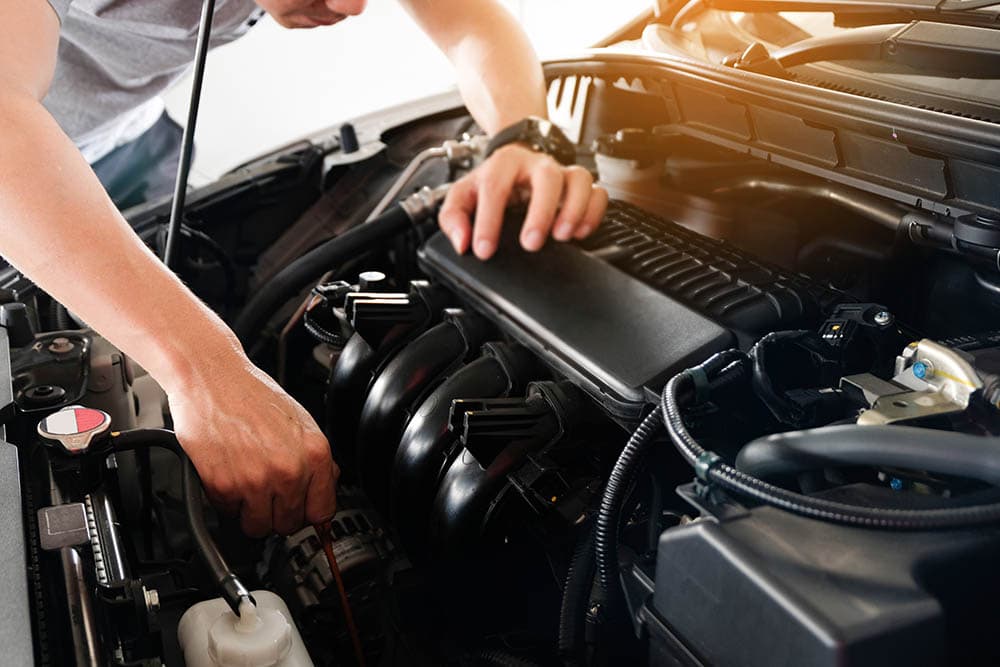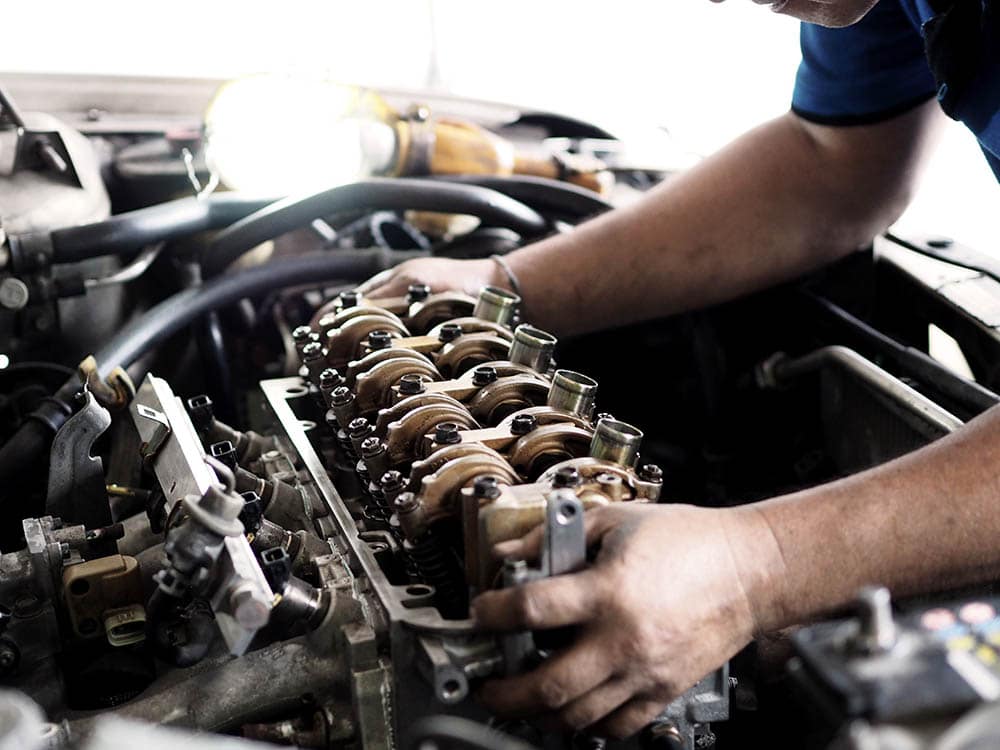How Much Does an Engine Weigh? Factors, Types, & FAQ
-
Pete Ortiz
- Last updated:

The engine is one component that catches our interest and attention in a new car. While we often focus on horsepower, torque rating, and fuel consumption, engine weight is a crucial factor as it affects your vehicle’s overall performance, speed, and fuel efficiency.
Typically, car engines weigh between 160–1,200 pounds (not including transmission). These values may vary depending on the material used, the number of cylinders and pistons, size, and model year.
In this article, we focus on the weights of different types of car engines and the main elements that determine general engine weight. Let’s jump right in.
 Weight of Different Types of Engines
Weight of Different Types of Engines
Engines are categorized according to the number of cylinders they have. From 2.0-cylinder engines to a V12, we look at the average weight of those different types of engines in pounds.
- 2-Cylinder Engines: On average, 2-cylinder engines weigh between 165–220 pounds. However, they are rare to come by nowadays. Some of the cars that use them are Volkswagen XL Sport, the Honda N600, and the 2014 Alfa Romeo Mito.
- 3-Cylinder Engines: 3-cylinder engines are almost similar to their 2-cylinder counterparts both in design, performance, and weight. They weigh between 145-240 pounds on average and are used in Nissan’s Batmobilesque ZEOD RC, among other automobiles. However, Ford produced a tiny turbocharged, 3-cylinder Ecoboost engine that weighed 88 pounds only.
- 4-Cylinder Engines: Being quite unsophisticated, 4-cylinder engines are among the lightest engines that you will come across. You’ll most likely find them in old vehicles, and they weigh between 165–250 pounds when put on a scale.
- 6-Cylinder Engines: The average weight of V6 engines is 300–550 pounds. There are heavier V6 engines though, like the Chevrolet Citation Sedan 2.8 which weighs 2,491 pounds or the Jeep Cherokee 3.7i V6 that weighs 4,017 pounds. These types of engines are mostly used by sedans, minivans, and SUVs.
- 8-Cylinder Engines: They are commonly used in high-end luxury cars, trucks, and vans. If you put a V8 engine on a scale, expect it to weigh between 400–700 pounds. This type of engine has an efficient combustion system and produces a lot of power and torque.
- 10-Cylinder Engines: The weight of 10-cylinder engines typically falls between 650–1,500 pounds. While this is just the average weight, other engines may weigh as high as 2,000 pounds. Thanks to their high power output, these types of engines are commonly used in heavy-duty trucks.
- 12-Cylinder Engines: The V12 engine is designed to weigh lighter while producing the highest power intensity possible. They have two rows, each containing six pistons that move up and down simultaneously to reduce the total size (height) and weight of the engine. The average weight of V12 engines ranges from 750–1,000 pounds. These engines are usually used in racing cars, and the first production cars to use them were the 1915 Packard Twin Six and the 1917 Widely Pathfinder.

The table chart below shows the weights of different engine types in summary:
| Engine Type | Average Weight in Pounds |
| V3 | 145–240 |
| V4 | 165–250 |
| V6 | 300–550 |
| V8 | 400–700 |
| V10 | 650–1,200 |
| V12 | 650–1,000 |
Does Engine Weight Affect Vehicle Performance?
Engine weight doesn’t absolutely determine the performance of a vehicle. Rather, the ratio of power to weight is a better metric for estimating performance.
Nonetheless, engines perform better when their weight is lower. This is because heavier engines tend to reduce braking performance when stopping and also make it troublesome to switch lanes and make turns.
On the other hand, lighter engines will cost the vehicle less fuel to move. That’s why automakers are opting for lightweight materials when constructing their engines. For instance, BMW has long been interested in carbon fiber production while Jaguar engines are made of aluminum.
Overall, it is safe to say that an engine’s weight indirectly affects the performance of a vehicle. The smaller your car’s engine is, the better the car will perform.
The 4 Factors That Affect the Weight of Car Engines
Which factors influence the heaviness or lightness of a car engine? Let’s take a detailed look.
1. Engine Size

The biggest determinant of an engine’s weight is its size. Also referred to as displacement or capacity, your engine’s size is determined by the number of cylinders contained within the internal combustion system.
A smaller size or displacement translates to less engine weight since the weight gets tacked on whenever a cylinder is added. It also means the engine has less space for air and fuel ignition, and vice versa is true.
As automobile technology keeps advancing, automakers are designing smaller and smaller engines because they are proving more efficient than large ones. This efficiency is visible in the fuel economy and power output.
2. Material
The material used for constructing engines also plays an important role in their weight. Some of the materials used to make engines are aluminum, plastic, iron, and carbon fiber. All of them have varying densities.
Despite boasting of a high power-to-weight ratio, carbon fiber is expensive to use. Automakers prefer using cast iron to save on costs, but since they have a poor power-to-weight ratio, they settle on aluminum.
Old engine models tend to weigh more than newer models because most of them were constructed using cast iron while modern models are made of aluminum. For instance, the Mercedes V8 that’s aluminum-made weighs 450 pounds, while its preceding iron-made variant weighs 100 pounds more.
3. Model Year

Another factor that influences engine weight is its release year. Due to technological advancements in the automobile sector, automakers have downsized many parts of the engine while also improving its efficiency and performance. While new age technology has also introduced additional accessories, sensors, and modifications, it has given way to small-sized engines that are typically lighter.
4. Engine Design
Engine design refers to the shape in which the cylinders, spark plugs, pistons, crankshaft, intake manifold, and exhaust manifold have been configured. If these components are few, the engine will be lighter.
Diesel vs. Gasoline Engine Weight
Diesel engines are commonly heavier than gasoline engines and the reason points to the principle of compression ignition.
Unlike gasoline engines, the combustion process in diesel engines is not only rough but also uncontrolled. Therefore, they need a dense structure to manage the vibration and minimize the noise. As a result, diesel-powered engines will have twice as much compression ratio as gas engines. They will require a heavy and dense block to manage this pressure.
It is also essential to understand that diesel fuel molecules are larger and denser than gas. One gallon of diesel is 7.1 pounds, whereas that of gasoline measures 6.3 pounds. Generally, it can explain why diesel combustion systems are bulkier and heavier.
 Conclusion
Conclusion
After reading this article, it’s evident that the most significant factor influencing engine weight is the material chosen for its construction.
As new cars are developed daily, the engines are getting smaller, lighter, and more powerful. While they can cause menace on the road, lightweight engines can also help you with fuel management, speed, and general vehicle performance.
Being armed with a good understanding of engine weights and their significance, it’s time you decided on the type of engine you want. But always remember to prioritize your road safety!
- How Heavy Is An Engine? [Car Motor Weight Chart] – AxleWise
- Car engine Weight
- How Much Does a Car Engine Weigh
- How Much Does a Car Engine Weigh
- How Much Does a Car Engine Weigh?
- Engine Power
- How Much Does a Truck Engine Weigh?
- Does engine weight affect vehicle performance
- Engine materials in relation to weight
- Transmission weight of a typical car engine
Featured Image Credit: A_stockphoto, Shutterstock
Contents

 Weight of Different Types of Engines
Weight of Different Types of Engines